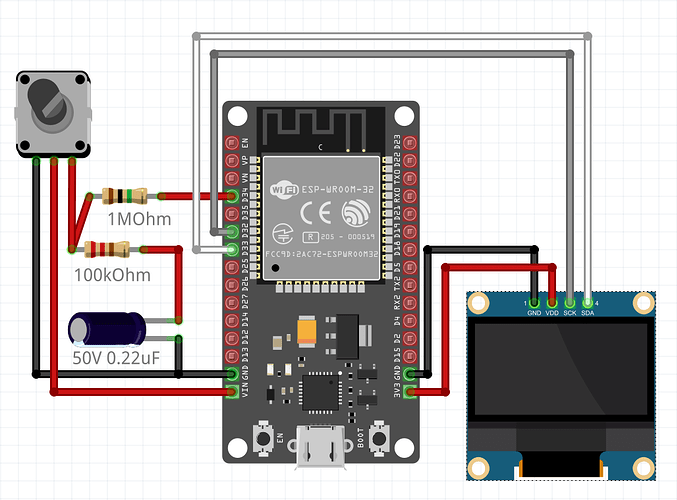Hi everyone. I’m new in the esp32-world, and I have a probably “noob-question”.
I build a device that should control a ventilation speed by potentiometer (it uses a voltage from 0 to 5v DC for set a motor freequency). So I got in my setup a esp32, motorized potentiometer (ALPS), 2-relay module (for controling the potentiometer’s motor direction) and 1306 OLED display for visulaize actual voltage in percent (0% = 0V DC… 100% = 5V DC). So the problem I have is the sensor (+ display) that shows a huge range of percentage, like from -3% to 146%… And I’m not able to calibrate it properly, even with 10 decimals, every time getting -3 - 1(46)% or smaller range, like 15-95%… the pin used as sensor is connected with resistor, so real voltage that comes to it is about 0.1V DC to 2,5V DC. Here is the script I’m using:
esphome:
name: espex
friendly_name: espex
esp32:
board: esp32dev
framework:
type: arduino
# Enable logging
#logger:
# Enable Home Assistant API
api:
encryption:
key: "key"
ota:
- platform: esphome
password: "blabla"
wifi:
ssid: !secret wifi_ssid
password: !secret wifi_password
# Enable fallback hotspot (captive portal) in case wifi connection fails
ap:
ssid: "Esph2"
password: "blabla"
captive_portal:
sensor:
- platform: adc
pin: 34
name: "pot_position"
id: pot_position
accuracy_decimals: 0
update_interval: 200ms
raw: True
device_class: voltage
attenuation: 12dB
samples: 99
unit_of_measurement: “%”
filters:
- multiply: 0.00095238
- calibrate_linear:
- 0.00000000 -> 0.00
- 1.25000005 -> 50.00
- 3.89995555 -> 100.00
- platform: template
id: pot_raw
name: "pot_raw"
lambda: return id(pot_position).state;
switch:
- platform: gpio
pin: 25
name: "Relay #1"
id: relay1
icon: mdi:fan-minus
on_turn_on:
then:
- display.page.show: page2
- component.update: oleg
- switch.turn_on: relay1
- delay: 50ms
- switch.turn_off: relay1
- display.page.show: page1
- component.update: oleg
interlock: [relay2]
- platform: gpio
pin: 26
name: "Relay #2"
id: relay2
icon: mdi:fan-plus
on_turn_on:
then:
- display.page.show: page2
- component.update: oleg
- switch.turn_on: relay2
- delay: 500ms
- switch.turn_off: relay2
- display.page.show: page1
- component.update: oleg
interlock: [relay1]
font:
- file: "fonts/Roboto-Regular.ttf"
id: font_small
size: 12
- file: "fonts/Arial.ttf"
id: font_large
size: 32
- file: "fonts/Arial.ttf"
id: font_mid
size: 22
i2c:
sda: 33
scl: 32
scan: true
display:
- platform: ssd1306_i2c
model: "SSD1306 128x64"
address: 0x3C
update_interval: 200ms
id: oleg
pages:
- id: page1
lambda: |-
const int screen_width = 128;
const int screen_height = 64;
// gauge center
const int center_x = screen_width / 2;
const int center_y = screen_height + 10;
const int radius = 60;
// value in percent
int percent = (int)(id(pot_position).state);
// angle for gauge fill
float filled_angle = (percent * 180.0) / 100.0;
// drawing gauge
for (int deg = -90; deg <= 180; deg += 6) {
float rad = (deg - 180) * M_PI / 180.0;
int x0 = center_x + cos(rad) * (radius - 6);
int y0 = center_y + sin(rad) * (radius - 6);
int x1 = center_x + cos(rad) * (radius);
int y1 = center_y + sin(rad) * (radius);
if (y0 >= 0 && y0 < screen_height && y1 >= 0 && y1 < screen_height) {
if (deg <= filled_angle) {
it.line(x0, y0, x1, y1); // active zone
} else {
it.draw_pixel_at(x1, y1); // passive zone
}
}
}
// print value numbers in center of display
it.printf(center_x, 50, id(font_large), TextAlign::CENTER, "%d%%", percent);
- id: page2
lambda: |-
it.printf(50, 0, id(font_mid), "ON");
it.printf(15, 20, id(font_mid), "REMOTE");
it.printf(10, 40, id(font_mid), "CONTROL");



